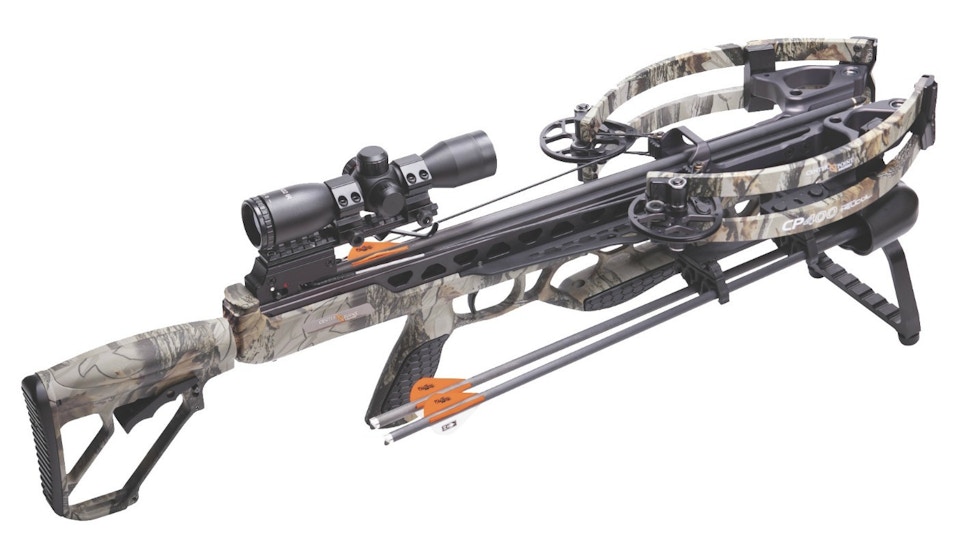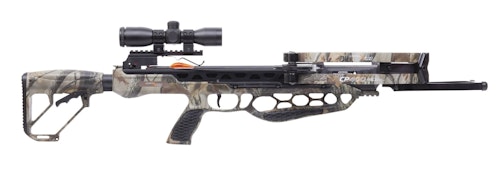Hunting with today’s innovative crossbows is a pleasure compared to the models that were available just a decade ago. A perfect example is CenterPoint’s new CP400. The CP400 is “ultra-compact,” only 6 inches wide axle-to-axle when cocked, which makes it as slender as any crossbow on the market, including competitive models priced much higher.
There is much for hunters to be excited about with the new CP400. The crossbow comes “mostly” assembled, meaning only the scope and quick-detachable quiver need to be installed upon receipt. The quiver mount is an ambidextrous, one-screw unit that attached in seconds. The owner may have to loosen a few quiver mount screws depending on if he’s a lefty or righty, but the entire process takes less time than it took to write this paragraph. All tools are provided except a large, flat-head screwdriver for attaching the scope mounts to the Picatinny rail.
The CP400 comes with a 3x32 illuminated scope (red and green) that must be mounted by the owner. Because there is no recoil to consider, I like to have my scope as close to my eye as possible. Also, because I have short arms, I want to be able to set the lockable, adjustable tactical buttstock as far ahead as it will go. Up close and personal, the crossbow seems to fit me like a glove, which is precisely what I want when hunting from a blind or out of a treestand. At just under 32 inches long, the CP400 is one of the most compact crossbows on the market.
I also like the fact that CenterPoint provides flip-up scope caps with the CP400 package. I don’t use scope caps as a general rule when the weather is favorable, but I do like using them when snow, rain or wind-blown dust become issues. The covers are sturdy, tight and silent, even when flipping them up or to the side (shooter’s choice on that one).
Other useful features include the folding stirrup, which came in extremely handy during assembly. The crossbow essentially becomes its own vise, making installation of the scope and mounts a breeze. No extra hands are needed during the process, and the stirrup flips up when done and stays solidly in place for cocking and carrying.
I was impressed with the adjustable tactical stock, which locks in place. I found the pass-through foregrip to be a handy safety feature. I have never lost a fingertip while shooting a crossbow, but I know hunters who have, and not one of them said it was a fun experience. The CP400 allows shooters to keep their fingers well away from the rail and string. The integral fluted flange provides additional protection for crossbow shooters with extra-long fingers.
The CP400 package includes a unique sled-design rope cocker that uses two grooves to hold the string while the sled slides along the rail back to the trigger assembly. It takes only a moment to understand the process, which differs only slightly from typical double-hook ropes. By the time I finished sighting in, I was a master at attaching the sled and cocking the crossbow, which is an important consideration when follow-up shots are necessary.
I am happy to report that CenterPoint provides and recommends standard half-moon-nock arrows for the CP400. In my opinion, a specified arrow should be part of every crossbow package simply because “innovative” proprietary designs can complicate matters, ruin crossbows and void warranties. I hope manufacturers follow CenterPoint’s lead and stick with the basics while working harder to make crossbows lighter, narrower and more accurate.
Yet another positive aspect of the CP400 is it comes with a 3x32 illuminated scope that is actually designed for crossbows and is not just a slap-on riflescope. The reticles are simple and clearly marked at 10-yard increments from 20 to 100 yards. This new window of 100 yards seems to be the trend in crossbow shooting. It’s always been known that modern hunting-type crossbows can propel an arrow out to 100 yards and beyond. This provides many “possibilities,” but in a hunting situation in typical habitat, 40 yards can be considered a long poke. Those who hunt in more open-country may set their own limits on distance-accuracy.
I like the CP400’s provided scope because it is simple, easy to mount, clear and sharp with no distractions other than a useful tip etched at the bottom of the eyepiece: “Keep fingers down!”
On the Range
After precautionary tightening all screws, nuts and bolts, it was time to head to the range. As is often the case when sighting in after self-mounting a scope, I fully expected to be inches off at 10 yards. Still, the CP400 required only a couple of clicks of elevation and windage to put me dead on at that distance. Backing off to 20 yards, I added another cosmetic click just to bring my arrow up slightly. From that point, it was dead-on shooting out to 50 yards, which is about 10 yards farther than I care to shoot while hunting.
For testing purposes only, I shot a few groups at 80 and 100 yards and will concede I could easily have hit a motionless mature whitetail at those distances. However, when wind and thick cover are a possibility, I’d rather not risk it. I can wait for my target to get closer or move to more open cover. Past experience in the whitetail woods has shown me that tracking an arrow-shot deer after a poor hit is not fun. Get closer or wait for a better opportunity.
There were no flaws or malfunctions to report while on the target range. CenterPoint recommends lubing the rail every 12 to 15 shots. Of course, lubricate only the rail (slightly) and do not put wax or lube on the serving of the string, which will cause wax to build up inside the trigger mechanism, possibly causing cocking or shooting issues down the road.
On the roving range, the CP400 was a joy to carry thanks to its 6-inch axle-to-axle width and well-distributed, evenly balanced 7.8-pound overall weight. With quiver and sling (not included) attached, the crossbow was closer to 8 pounds. I had no trouble carrying, cocking or shooting it even though there was close to 15 inches of frozen, crusty snow on the ground. The adjustable stirrup stayed put throughout even though I used it in flip-down mode while retrieving arrows from the targets. I like to work “adjustable” features to the max to see if and how long they are truly adjustable, so I kept testing the stirrup and buttstock for over 100 shots while roving. The CP400 came through with flying colors in all testing, but especially when shooting from a blind and when fired out of a climbing treestand. Cocking any crossbow in a climber takes some creativity on the part of the shooter, but I had no trouble getting the CP400 cocked for shots to the left, right and center. By folding the stirrup down, I was able to give myself another 8 inches of room in the blind, which makes a difference when attempting to shoot out of left- or right-side windows.
There is little to complain about the CP400 other than my perennial gripe about not including a sling in the package. I have slings, as do most other shooters, but it would be nice to include one with each crossbow package. Of all the implements I hunt with a crossbow is the most awkward, unwieldy and difficult to carry. A high-quality sling can make all the difference, especially when traveling to and from hunting sites or when carrying climbers, ladders and other gear.
The CP400 package includes the crossbow, 3x32 illuminated scope, string stops, quick-detachable quiver, three 20-inch arrows, unique sled-design rope cocker and features a limited five-year warranty. The suggested MSRP is $999.99. For more information, visit www.centerpointarchery.com.
Published Specs
- Model: CP400
- Draw Weight: 200 pounds
- Power Stroke: 13 inches, half-moon nock
- Arrow Length: 20 inches
- Arrow Speed: 400 fps
- Trigger Pull: 3.1 pounds; dry-fire inhibitor
- Sights: 3x32 illuminated scope provided
- Cocking Device: Sled-type rope cocker provided
- Overall Length: 31.75 inches
- Axle-to-Axle Width: 6 inches cocked, 10.5 inches uncocked
- Weight: 7.8 pounds
- Other Features: Compression fiberglass Quad limbs, composite stock, ambidextrous safety, adjustable tactical stock with pass-through foregrip, folding stirrup, string stops, QD quiver and a five-year warranty.
- MSRP: $999.99








